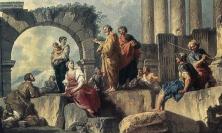On Sunday 26 May, we observe the Solemnity of the Most Holy Trinity. The Trinity can be a ‘dauntingly abstract concept ‘, says John Moffatt SJ, but it is important for us to use words and images, as far as we can, to explore the truth that it represents: ‘the single origin of all things is in essence relationship’.
If your eyes wander upwards from the front row of the Jesuit church in Innsbruck, you will notice on the inner dome above the altar not elaborate pictures, but a simple triangle. This rather plain and slightly cryptic ornamentation draws the eyes and the mind to the ancient Christian teaching that God is three and God is one. It also reinforces the impression we can often have, that after the powerful narratives of Lent and Easter, which take us from creation to Pentecost, the Trinity remains a dauntingly abstract concept. Nevertheless, this is a teaching that has been celebrated in the Western Church since the Middle Ages and one that has, perhaps surprisingly, been a frequent subject of Christian mystical experience, from Julian of Norwich to Teresa of Avila. It is the distinctively Christian understanding of God, the origin of all things.
For those who enjoy philosophical philology, the three-hundred-year journey from the instruction to baptise in the name of the Father, and of the Son and of the Holy Spirit, to the creed that we recite each Sunday is fascinating. We see how the early Christians’ intuitive experience of Father, Son and Spirit was first justified simply with reference to scripture. Then the inconsistencies began to be noticed, tough questions got asked and intellectuals began to make their own options. Christianity had to adapt its language and adjust its claims in a world that prized logic, coherence and philosophical thought.
Over the years Christian leaders, arguing amongst themselves, were forced to make decisions, to try and clarify what it was that they believed. A technical language, remote and abstract to us today, emerged. The narratives of the New Testament were augmented with words like ‘being’, ‘hypostasis’, ‘person’, ‘relation’, alongside everyone’s favourite, ‘consubstantial’. The fourth-century struggle to find a coherent way of talking about God underpins our creed. It allows us to say of the Lord Jesus Christ that he is true God from true God and that the Spirit, the Lord, the giver of life, is worshipped and glorified together with the Father and the Son.
Why is it so important for us to find some way of talking that does not reduce three persons to three aspects of a single entity and yet does not leave us with the confusion of three separate Gods either?
One set of reasons is abstract, but important for those to whom ideas matter in their life of faith. We find in Aristotle the philosophical insight that all things arise from a single origin. Yet Aristotle’s changeless, solitary prime mover and sustainer of being seems to have little directly to do with our human experience. However, if the single origin of all things is in essence relationship, we can begin to see why the deepest truth in the universe around us is not the laws of physics, but the law of love. Human beings are not atoms in the void, but beings made for love and community. If the God and origin of all things is in essence unity and self-gift, then this affects how we think about the meaning of our own struggle to survive together on this planet.
The writers of the fourth century constantly draw on images from the New Testament to paint a picture of a God whose dynamic creativity is still at work. The Spirit transforms the hearts of believers, enabling them to follow the pathway of the Word and find their way home to the presence of the Father. The divine three, who share all they have in common, call, guide and raise up humankind to participate in the oneness of their glory and delight.
But they are also careful to point out the limits of what they say and indeed of what can be said. In the end our words and concepts crumble when we speak of God. We are left with images to guide our understanding in the direction it needs to go. Three suns, one light. One ray of light refracted into three colours. Three notes forming a single harmony. These give us hints and glimpses of how it can be that the reality behind all things begins and ends in love.
John Moffatt SJ teaches Scripture at the Jesuit Institute, South Africa and is the author of the blog, Letting the Porcupine out of the Bottle.
![]() ‘The Trinity: On Loving Love Loving ’ by James Hanvey SJ on Thinking Faith
‘The Trinity: On Loving Love Loving ’ by James Hanvey SJ on Thinking Faith![]() ‘Paul, Trinity and Community’ by Michael Mullins on Thinking Faith
‘Paul, Trinity and Community’ by Michael Mullins on Thinking Faith






